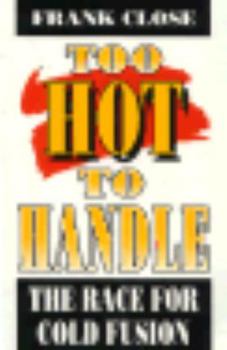Too Hot to Handle: The Race for Cold Fusion
Select Format
Select Condition 
Book Overview
Frank Close, a leading physicist and talented popular science writer, reveals the true story of the cold fusion controversy--a story ignored until now in spite of the glare of publicity surrounding... This description may be from another edition of this product.
Format:Hardcover
Language:English
ISBN:0691085919
ISBN13:9780691085913
Release Date:April 1991
Publisher:Princeton University Press
Length:392 Pages
Weight:1.70 lbs.
Dimensions:1.2" x 6.5" x 9.5"
Customer Reviews
2 ratings
Sun on Earth
Published by Thriftbooks.com User , 14 years ago
1. The fusion reaction produced 26 watts per centimeter cubed, about four and half times the energy put into it, heated up to 5000 degrees F and vaporized a block of palladium, destroyed a fume cupboard, and damaged the concrete floor. 2. The evidence of fusion in addition to heat was the detection of neutrons, tritium and helium. 3. Palladium has an affinity for hydrogen and can absorb 900 times its own volume of hydrogen. Hydrogen pours between the empty atoms of Palladium and it fills up the metal by some ten percent in all directions, putting it under great internal pressure - many thousand times the atmospheric pressure. The increased closeness of the hydrogen was believed to increase the likelihood of fusion occurrences. 4. 1927, Peter and Paneth used hydrogen gas from water. Paneth used Palladium as the cathode (positively charged) so that the hydrogen was attracted to it. The electric voltage forced the hydrogen into the Palladium until the hydrogen was several thousand times the atmospheric pressure. The Helium and energy device was not granted a patient. 5. Two protons can not make one, helium. They can survive the electrical disruptions on their own. Stable helium contains neutrons. 6. d=deuterium p=proton T=tritium He=helium then d(np)+d(np)=he3(npp)+n or d(np)+d(np) = he3(npp)+p 7. The combined mass of the final produce is smaller than the combined initial mass of the initial nuclei. The mass has been converted into energy E=mc^2. Energy is manifested as kinetic energy. 8. Nuclear process release a million more energy than chemical processes, MeV, Million electron volt. 9. A neutron carries away 2.45 MeV of energy, a proton carries away 3 MeV. 10. Two deuterium atoms combining into Helium 4, give off a gamma ray or 24 MeV of energy. The He4 is ten million times less frequent than the neutron or tritium production channels. 11. For fusion to be successful more energy must be released than is consumed. 12. A muon is 207 times heavier than an electron. Muonic hydrogen would be 207 times smaller than ordinary hydrogen. Muons have a mean life of 2.2 millionths of a second. A muon would behave much like a neutralized proton or neutron. 13. Cold fusion seem probable with muon hydrogen in proximity to deuterium; the proton fuses with the Deutrium forming Helium 3 and energy. The energy generated can kickout the muon. 14. Will muon technology produce more energy output than the particle accelerated energy used to create the muon? 15. INEL created a gold lined stainless steel container that could hold deuterium and tritium gases and managed to achieve a rte of eight fusons per muon, where the energy released exceeded the rest energy of a muon. Electrochemistry: 1. The affects of electrochemistry are high pressures and high temperatures, two conditions required to produce fusion. Fleischmann and Pons used 4 volts to split sodium chloride into sodium and chloride atoms. By heat it would have required a temperature of 40,000
A testament to the scientific method
Published by Thriftbooks.com User , 19 years ago
The fusion of light atoms found in water has been viewed as the holy grail for meeting global energy needs. To date, science has spent millions of dollars on fusion research, trying to create the effect in plasmas with temperatures of hundreds of million degrees fahrenheit. But what if there was a simpler way to fuse atoms? In 1989, two chemists believed they found it. The scientific community was initially turned on its ear by the announcement. The history of the "cold fusion" experiments and the quest to verify them are the subject of Frank Close's "Too Hot to Handle." Frank Close's book is really a cautionary tale of what happens when sloppy science meets with equal amounts of greed, media hype, and a genuine desire to believe in the impossible. "Too Hot to Handle" is a testament to those scientists who methodically examined cold fusion and relied on the scientific method to arrive at the truth. It also examines the realm of possibilites (particulalrly the negative ones) that would open should fusion power become commercially viable. Frank Close writes his book with general audiences in mind, but a basic knowledge of atomic physics (the nucleus, neutrons, protons, radiation, gamma rays, fission, and fusion) is a prerequisite. He often repeats himself with explanations of the fusion processes and their consequences. Readers should be forewarned that Close uses British spellings and grammatical conventions. The book also looks like it was edited in a hurry, as there are several typographical errors in the text that slow down readability when they emerge. "Too Hot to Handle" is a solid book that presents a lot of information compiled over a very short amount of time. It addresses a phenomenon that has been discounted by most scientists, but some still persist in believing in it. Hopefully this work will serve as a light in the darkness to future scientists, regardless of their field of study.





